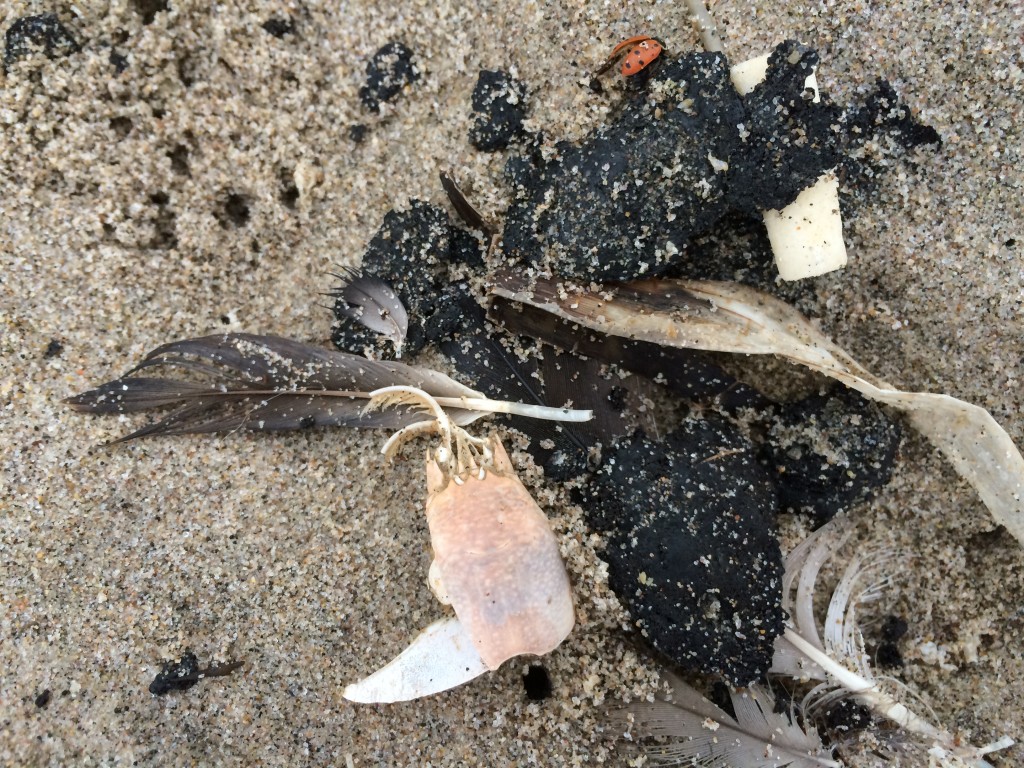Grunion & Sand Crabs in harms way
There are many critters particularly at risk with this oil spill. While our historic worry/focus has been on our rocky intertidal communities and on warm fuzzies (such as these cute marine mammals and endangered sand-nesting birds), other critters are at risk too. In particular the animals dwelling in the swash zone of our sandy beaches. What I am most worried about here are the sand crabs (Emerita analoga) that are the food for a huge number of beach-dwelling birds and animals and our California grunion (Leuresthes tenuis).
Sand crabs make their living migrating up and down the beach with the tides (they live in the sand, sticking up their food-collectors to harvest their planktonic food and the waves wash over their sand-home), keeping themselves right at the swash zone where the waves hit. That’s right where all these tarballs are washing up. As of yesterday, we have been finding dead sand crabs in amongst the freshest wave of tarballs arriving on our beaches in Ventura County.
It is too early to say if we are seeing a significant mortality event within our sand crab population, but it is concerning that we are seeing so many dead guys (not mere cast-off exoskeletons or dead juveniles).
Given the fact that sand crab numbers have been low this year prior to the onset of the pipeline break/oil spill, any tar-induced mortality might prove harmful to the population and sandy beach community overall. The bright side of this is that these are resilient and highly variable populations and we may see no effect.
When it comes to California grunion, the worry is that we are in peak spawning time. These amazing fish swim up to the beach at night to lay their eggs before rolling and flopping back into the water. Their eggs chill out in the sand until they are ready to hatch with the next series of high tides.
Both sand crabs and grunion are vulnerable to both the toxic oil and the clean-up process alike. Simply skimming the oil off the very uppermost surface of the sand is not an issue, but digging into the sand translates into possibly digging into these guys and killing them. Clean-up crews need to be as careful as is reasonable.
See this e-mail from our queen grunion champion Dr. Karen Martin:
Whatever their source may be, these tar balls have the potential to impact beach and nearshore animals and plants, including the California Grunion…
[the impacted areas] are known spawning locations for the California Grunion, an endemic, iconic marine species. Any eggs still on shore this weekend are ready to hatch and likely to emerge during the high tides at night over the past and next few days. However, the tar balls in the intertidal zone are very nearly in the location of the band of buried grunion eggs.
With all appropriate human safety precautions, when cleaning the beaches, it is important to leave the sand as undisturbed as possible if the contamination is only at the surface. The best practice seems to be gentle manual removal of the surface petroleum, with flat shovels or hand rakes. Some people are using cat-litter scoops.
We are still in the midst of the peak spawning season for the California Grunion. The full moon Tuesday June 2 will be followed by nights with potential runs on Tuesday, Wednesday, Thursday, and Friday. Grunion usually spawn multiple times over their lifespans. It is rare that they die during spawning runs. If you do see an unusual mortality event, please let me know as soon as possible…
…Please recall that after this week the nests of eggs will be present on shore for the following two weeks. Keeping vehicles and other forms of disturbance above the high tide line of Tuesday’s highest tide is the best way to protect them.
Thanks for your care of our beaches and natural resources during this difficult time.


